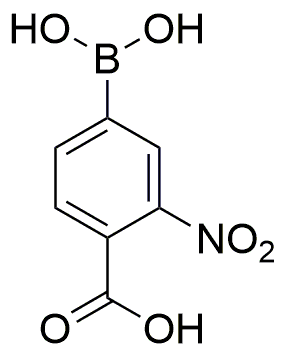4-Carboxy-3-nitrophenylboronic acid is widely utilized in research focused on:
- Drug Development: This compound serves as a crucial intermediate in the synthesis of various pharmaceuticals, particularly in the development of targeted cancer therapies that utilize boron-containing compounds for enhanced efficacy.
- Bioconjugation: It is employed in bioconjugation techniques, allowing researchers to attach biomolecules to surfaces or other molecules, which is vital in creating targeted drug delivery systems and diagnostic tools.
- Organic Electronics: The compound plays a significant role in the fabrication of organic electronic devices, such as organic light-emitting diodes (OLEDs), due to its unique electronic properties that enhance device performance.
- Environmental Monitoring: It is used in the development of sensors for detecting environmental pollutants, particularly in water quality testing, where its sensitivity to specific contaminants is advantageous.
- Chemical Research: This compound is valuable in synthetic organic chemistry for creating complex molecules, providing a versatile tool for researchers looking to explore new chemical pathways and reactions.
General Information
Properties
Safety and Regulations
Applications
4-Carboxy-3-nitrophenylboronic acid is widely utilized in research focused on:
- Drug Development: This compound serves as a crucial intermediate in the synthesis of various pharmaceuticals, particularly in the development of targeted cancer therapies that utilize boron-containing compounds for enhanced efficacy.
- Bioconjugation: It is employed in bioconjugation techniques, allowing researchers to attach biomolecules to surfaces or other molecules, which is vital in creating targeted drug delivery systems and diagnostic tools.
- Organic Electronics: The compound plays a significant role in the fabrication of organic electronic devices, such as organic light-emitting diodes (OLEDs), due to its unique electronic properties that enhance device performance.
- Environmental Monitoring: It is used in the development of sensors for detecting environmental pollutants, particularly in water quality testing, where its sensitivity to specific contaminants is advantageous.
- Chemical Research: This compound is valuable in synthetic organic chemistry for creating complex molecules, providing a versatile tool for researchers looking to explore new chemical pathways and reactions.
Documents
Safety Data Sheets (SDS)
The SDS provides comprehensive safety information on handling, storage, and disposal of the product.
Product Specification (PS)
The PS provides a comprehensive breakdown of the product’s properties, including chemical composition, physical state, purity, and storage requirements. It also details acceptable quality ranges and the product's intended applications.
Certificates of Analysis (COA)
Search for Certificates of Analysis (COA) by entering the products Lot Number. Lot and Batch Numbers can be found on a product’s label following the words ‘Lot’ or ‘Batch’.
*Catalog Number
*Lot Number
Certificates Of Origin (COO)
This COO confirms the country where the product was manufactured, and also details the materials and components used in it and whether it is derived from natural, synthetic, or other specific sources. This certificate may be required for customs, trade, and regulatory compliance.
*Catalog Number
*Lot Number
Safety Data Sheets (SDS)
The SDS provides comprehensive safety information on handling, storage, and disposal of the product.
DownloadProduct Specification (PS)
The PS provides a comprehensive breakdown of the product’s properties, including chemical composition, physical state, purity, and storage requirements. It also details acceptable quality ranges and the product's intended applications.
DownloadCertificates of Analysis (COA)
Search for Certificates of Analysis (COA) by entering the products Lot Number. Lot and Batch Numbers can be found on a product’s label following the words ‘Lot’ or ‘Batch’.
*Catalog Number
*Lot Number
Certificates Of Origin (COO)
This COO confirms the country where the product was manufactured, and also details the materials and components used in it and whether it is derived from natural, synthetic, or other specific sources. This certificate may be required for customs, trade, and regulatory compliance.


